Why would you want to trim the bushes?
Pruning or trimming the bushes is quite essential to ensure their healthy growth and to maintain the neat look of your landscape. Trimming serves multiple reasons, and cosmetic ones play not the most important role. That’s why gardeners pay a lot of attention to developing a sort of a trimming chart (calendar) for their gardens and keeping a close eye on trees and bushes to see what pruning steps have to be taken regarding each plant. However, most of the homeowners, who’ve never dealt with trimming plants too much before, are mostly scared to cut off the stems and branches. They’re afraid to harm the plant while trimming instead of assisting its normal and balanced growth and making it look much nicer for the sake of the general landscape.
So, bushes actually have to be trimmed for multiple reasons. Obviously, people prune them (just as the trees) to form their shape and keep them growing within the spot, designed for them. Moreover, trimming encourages the shrubs’ development. It makes them grow denser and produce more flowers. Secondly, it’s necessary to chop off the dead (dry) twigs and branches. You need to trim them both to improve the plant’s look and to prevent the bush from drying up even further and getting diseases and parasites, which are attracted to the dead stems. Also, all those annoying suckers, as well as the water sprouts have to be removed, so they don’t exhaust the plant and don’t make it grow unevenly and disproportionally. Weak and diseased stems or the ones that stick out and cling to people and clothing may be chopped off as well. And, it’s also important not to allow your hedges overgrow a certain point of their height to ensure the proper vision from and of the house and its entrance. That has a lot to do with the security matters. And finally, some local ordinances prohibit growing the hedges taller than a certain predetermined level.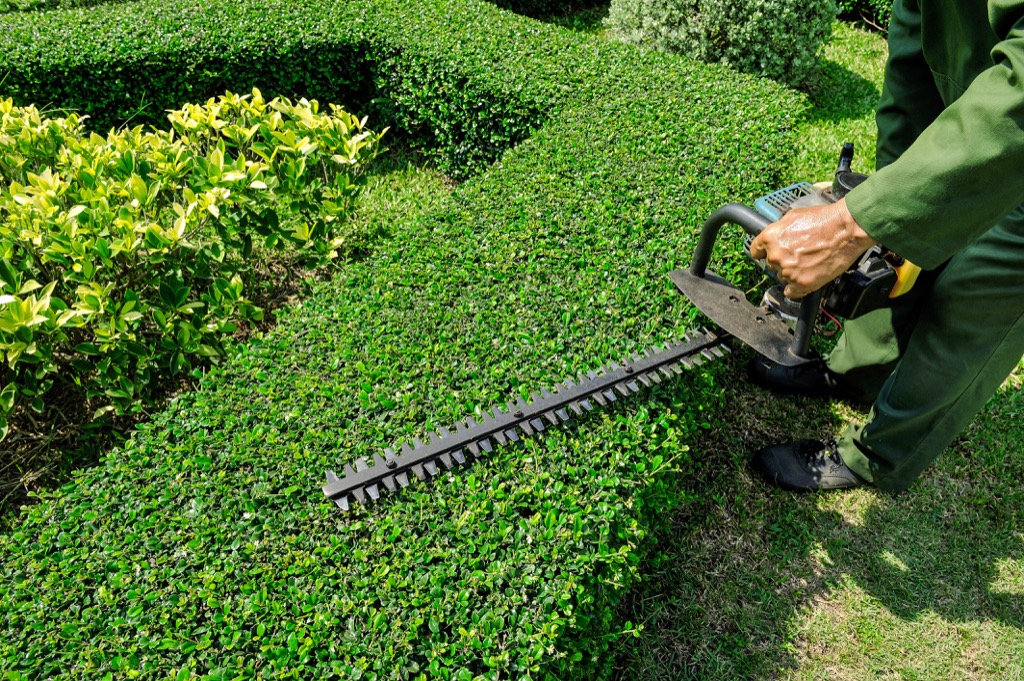
Bigger gardens (or just more sophisticated ones), which feature many types of bushes and hedges of various shapes and forms, decorative and fruit trees require more attention and care. It’s better to hire a professional gardener who’ll look after them and take all necessary trimming, watering, replanting, rejuvenation and landscaping procedures right in time. He will use proper techniques, adapted to the nature and growth peculiarities of each type of bushes, trees, grass, etc. So, if you’re an owner of such a marvelous garden that requires so much work that it may be turned into a part of someone’s job, I suggest that you may visit HireRush.com to hire an experienced local gardener. You’ll be sure that the plants are taken care of and that your landscape is maintained by a specialist. And, you’ll be able to learn some gardening tricks and tips from him.
But, if you have an average garden with typical bushes and hedges, which have to be trimmed from time to time, I’m sure that you’ll be able to cope with this task on your own. And we’re going to learn our way through this gardening procedure together. In the end, we can always consult with a gardener about how to prune bushes. So, let’s educate ourselves first and attempt trimming them being ‘fully armed’.
How and when to trim bushes
Despite the common misconception, not all bushes must be trimmed during the dormancy season, which falls on the late winter and early spring. This is done before the buds on bushes start ‘waking up’. Most bushes (including broad evergreen ones) may be trimmed at that time. In fact, trimming them early in the spring is highly beneficial, as when the spring comes into its force, their tissue will grow rapidly. So, the bushes will start up new stems and little branches, which will sprout out of the pruned stems close to the cut. So, pruning bushes at this time will positively affect their progressive and rapid growth.
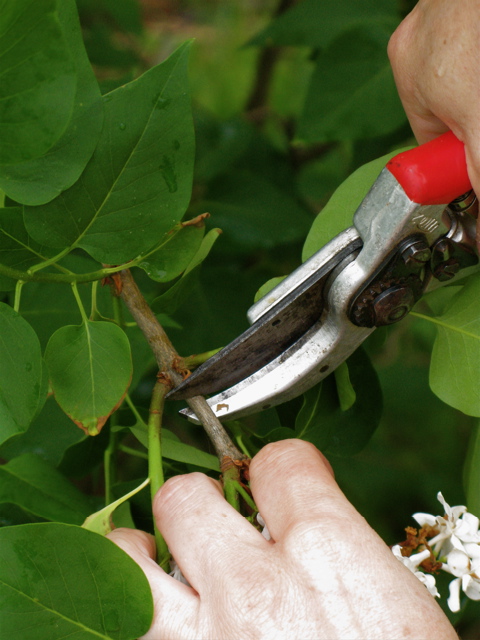 However, most bushes, which blossom in spring and early summer shouldn’t be trimmed before the spring kicks in. Moreover, gardeners don’t recommend touching them until they finish blooming. Otherwise, you’ll most likely cut off the last-year stems, on which the flowers are formed, so your bush won’t be able to produce them this season. This is especially true for lilac, rhododendron, forsythia and hydrangea bushes, as they are known for developing their inflorescences on old stems. So, if you trim them at the same time with other bushes (during the dormancy period), you will significantly reduce their blossom. Most rose bushes (climbing and old garden shrubs) fall within this category too. So, you should trim them right after they finish blossoming. However, you shouldn’t treat the modern rose bushes and repeat bloomers the same. It’s possible to trim them in order to keep them within a certain shape or just to get rid of the old stems. Overgrown bushes might be pruned in the early spring.
However, most bushes, which blossom in spring and early summer shouldn’t be trimmed before the spring kicks in. Moreover, gardeners don’t recommend touching them until they finish blooming. Otherwise, you’ll most likely cut off the last-year stems, on which the flowers are formed, so your bush won’t be able to produce them this season. This is especially true for lilac, rhododendron, forsythia and hydrangea bushes, as they are known for developing their inflorescences on old stems. So, if you trim them at the same time with other bushes (during the dormancy period), you will significantly reduce their blossom. Most rose bushes (climbing and old garden shrubs) fall within this category too. So, you should trim them right after they finish blossoming. However, you shouldn’t treat the modern rose bushes and repeat bloomers the same. It’s possible to trim them in order to keep them within a certain shape or just to get rid of the old stems. Overgrown bushes might be pruned in the early spring.
Various bushes, which are planted primarily because of their foliage, may be trimmed multiple times throughout the warm season. This will keep them neat and within the desired shape and size. Obviously, the main pruning should be done in early spring, but any occasional trimming won’t harm them, unless you decide to conduct a late summer or early autumn trimming. If you live in changing seasons conditions, this will put the bushes in danger. Why? As we’ve already agreed, trimming provokes more intensive growth of the bushes. Meanwhile, their growth is supposed to slow down as the cold season approaches. This makes the bushes (and trees) more cold-tolerant, which helps them survive the winter cold. But, if you trigger their growth at a wrong time, they might not be able to regulate their natural processes as they’re meant to. That’s why they may be damaged by cold.
And, trimming hedges throughout the summer and spring to keep them at a certain height and to cut off their random and weak stems is just an inevitable part of their maintenance. Evergreen bushes, which have needle-like leaves, may be slightly trimmed in the beginning of their growing season. Berry bushes are best trimmed in late winter. You’re supposed to cut off one third of their old (not young) stems and rejuvenate them by cutting of the ground-level branches.
Grape vines are the plants that require pruning the most. The fruit production directly depends on annual and extensive trimming. They have a main stem with a couple of lateral ones, growing from it, and those juicy and tasty grape bunches form on the shoots of young woody vines of the current season. That’s why gardeners and winegrowers chop off the old shoots close to the lateral vines to let the new ones develop. So, that should be done way before the growing season – during the dormant period. However, when it comes to pruning grape vines, each type of vines have to be treated differently. That’s why I suggest that you should consult with an experienced gardener and read specialized literature to figure out how to trim the ones you have properly.
The best ways to trim shrubs
As we’ve answered the most difficult subject of when the best time to prune shrubs is, we shall proceed to the practical part of the task. This means that we’re going to figure out how to trim bushes, specifically where and how to make a cut.
First of all, let’s decide on the tools. The most important thing is they have to be sharp. And, you have to invest in high-quality pruning shears, which may cut the stems and brunches up to ¾ of an inch in diameter. They’ll do for most of the bushes people have in their gardens. You’ll need looping shears or a hand saw to cut thicker old branches. And, separate tools are required to trim the hedges. Those are hedge shears, which are used to prune the tops of the hedges and shape them. Don’t forget about the basic gardener’s accessories like gloves and an apron.
Now, everybody knows that a flat cut or too steep one will damage the stem. But what’s the perfect pruning angle and direction?
Basically, there’re two types pruning cuts that allow reaching different results. The first one is called a heading cut. It promotes the denser growth of the bush and appearance of the new stems closer to the wound. The cutting direction will define the growth direction of the future sprouts. This technique allows decreasing the bush’s height and preserving its natural shape.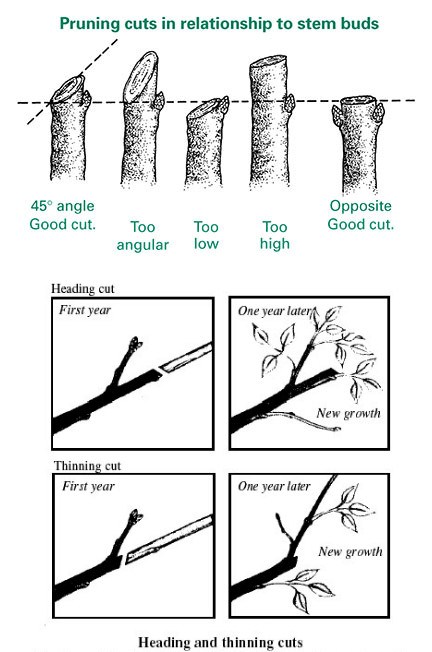
The second one is called a thinning cut. Gardeners use it to make the bushes less dense and cut off the branches at their attaching points, just above the bud. Such technique is also used in gradual rejuvenation of the bush, when one third of all old and unproductive branches is cut off each year until they’re completely removed.
Use the second technique to get rid of dead or broken stems and suckers. A proper trimming cut is made one quarter of an inch above the bud. Parallel or steep cuts aren’t good for a bush. The correct cutting angle is about 45o – just a half of the right angle.
Now, as you’ve learned the most important information on trimming bushes, you may go ahead and develop a trimming calendar for your garden and start pruning the bushes according to it.
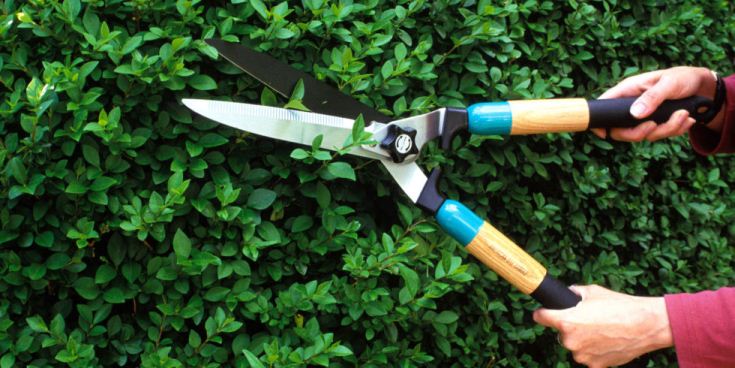

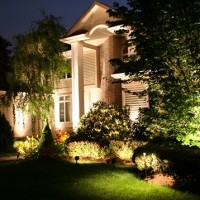
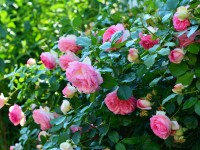


Great gob, guys! I read the article and use some recommendation from there. You said, I have to invest in high-quality pruning shears. I did. And guess what? I cut brushes like a pro. So maybe I’ll become your provider, who knows?)